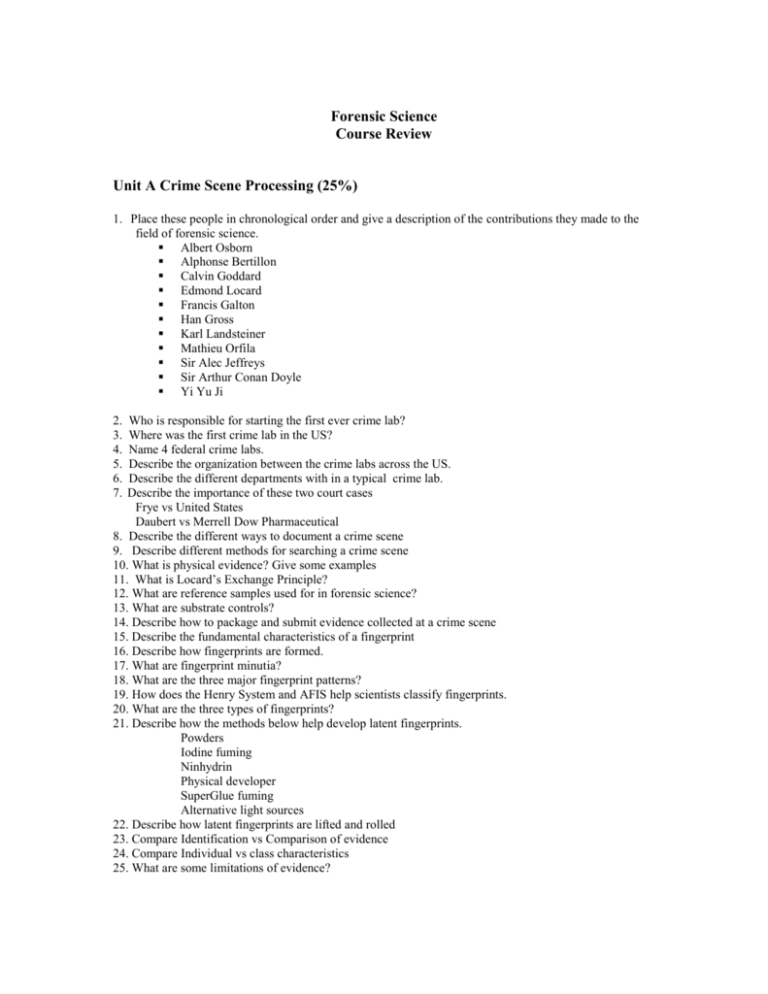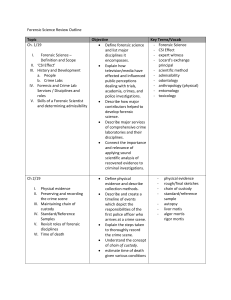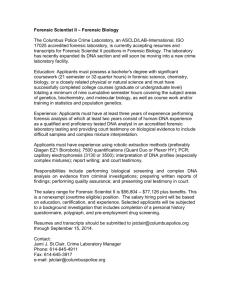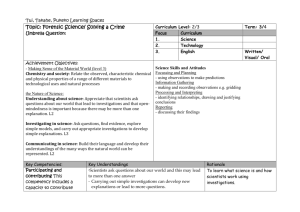Forensic Science
advertisement

Forensic Science Course Review Unit A Crime Scene Processing (25%) 1. Place these people in chronological order and give a description of the contributions they made to the field of forensic science. Albert Osborn Alphonse Bertillon Calvin Goddard Edmond Locard Francis Galton Han Gross Karl Landsteiner Mathieu Orfila Sir Alec Jeffreys Sir Arthur Conan Doyle Yi Yu Ji 2. 3. 4. 5. 6. 7. Who is responsible for starting the first ever crime lab? Where was the first crime lab in the US? Name 4 federal crime labs. Describe the organization between the crime labs across the US. Describe the different departments with in a typical crime lab. Describe the importance of these two court cases Frye vs United States Daubert vs Merrell Dow Pharmaceutical 8. Describe the different ways to document a crime scene 9. Describe different methods for searching a crime scene 10. What is physical evidence? Give some examples 11. What is Locard’s Exchange Principle? 12. What are reference samples used for in forensic science? 13. What are substrate controls? 14. Describe how to package and submit evidence collected at a crime scene 15. Describe the fundamental characteristics of a fingerprint 16. Describe how fingerprints are formed. 17. What are fingerprint minutia? 18. What are the three major fingerprint patterns? 19. How does the Henry System and AFIS help scientists classify fingerprints. 20. What are the three types of fingerprints? 21. Describe how the methods below help develop latent fingerprints. Powders Iodine fuming Ninhydrin Physical developer SuperGlue fuming Alternative light sources 22. Describe how latent fingerprints are lifted and rolled 23. Compare Identification vs Comparison of evidence 24. Compare Individual vs class characteristics 25. What are some limitations of evidence? Unit B: Death Investigation (20%) 26. 27. 28. 29. 30. 31. 32. 33. 34. 35. 36. 37. 38. 39. 40. 41. 42. Write a job description for a medical examiner Write a job description for a forensic anthropologist. Write a job description for a forensic odontologist. Write a job description for a forensic archeologist. Write a job description for a forensic entomologist. What is the difference between a forensic pathologist, a medical examiner and a coroner? Describe the process of an autopsy including the external exam, the internal exam, the collection of evidence, and toxicology Describe the five possible manners of death that can be put on a death certificate. Give some examples for each of the causes of death Asphyxiation Exsanguination Sharp force trauma Blunt force trauma Chemical trauma Electrical trauma Explain how each of the following can be used to determine the post mortem interval (PMI) or time of death. Algor mortis Livor mortis Rigor mortis What methods would an anthropologist use to search and reconnaissance a clandestine grave? Explain the techniques and challenges an anthropologist would encounter with excavating a grave. How can an anthropologist identify a person through their skeletal remains? Explain how photographic superimposition and facial reconstruction is used by a forensic anthropologist. Explain how dental records and bitemarks are used in a crime investigation. Explain the typical life cycle of an insect such as a blowfly. Explain how a forensic entomologist can use insects and climate data to determine the PMI Unit C: Forensic Science (55%) Drugs and Toxicology 43. 44. 45. 46. 47. 48. 49. 50. 51. 52. Describe the categories of illicit drugs and give examples for each. Explain the difference between physical and psychological dependence. Explain the different categories for drugs under the current drug control laws. Explain the different ways to screen for and analyze drugs. Write a job description of a forensic toxicologist. Explain what ADMET stands for in toxicology. Describe the different methods for screening and analysis in toxicology. Describe the affect alcohol and marijuana have on the body. Explain the NC law on blood alcohol content. Describe some different field sobriety tests used by law enforcement . Blood and DNA 53. What are the major components of blood? 54. Explain the difference between antigens and antibodies and how they work together? 55. Describe the different blood types. 56. Explain the different forensic tests that can be performed on blood and why they would be used. 57. Explain some general principles regarding blood spatter and how it can be used in a crime investigation. 58. Describe the structure and function of DNA 59. List some sources from which DNA can be collected in an investigation. 60. Describe each of the following DNA technologies: Restriction Fragment Length Polymorphisms Polymerase Chain Reaction Short Tandem Repeats Mitochondrial DNA CODIS Trace Evidence 61. 62. 63. 64. 65. 66. 67. 68. 69. 70. 71. 72. 73. 74. 75. 76. 77. 78. 79. 80. 81. 82. 83. 84. 85. 86. 87. 88. 89. 90. 91. Describe the structure of hair. Explain how hair grows? Explain the significance of follicular tags found on hair. Describe the forensic analysis of hair. What can be learned about a person from their hair? Describe the different categories of fibers and give examples. Describe the techniques that forensic scientists use to compare and identify fibers. Describe the different types of glass?. Explain how forensic scientists can determine the direction and order of two bullet holes found in glass. Explain how flotation and refractive index is used in forensic glass analysis Describe the techniques that forensic scientists use to compare and identify soil. List some types of impressions that can be left at a crime scene. Explain how casts are made from impressions and how they are compared. Describe the anatomy of a gun. Explain bore, caliber, and gauge. Explain how marks on shell casing and bullets are made and how they are used forensically. Explain how gunshot residue is used to determine the distance of the shot Explain how primer residue is used forensically. Explain the four different types of ballistic regimens that bullets encounter. Describe the techniques that forensic scientists use to compare and identify questioned documents. Describe how transcript documents can be forensically analyzed. Describe the different types of document alterations. Explain how ink and paper can be forensically analyzed. Describe the anatomy of a computer and how it works. Explain how data is stored and retrieved on a computer. Describe the techniques that forensic scientists use to analyze a computer involved in a crime. Describe the basics of the internet. Explain how to protect your privacy on the internet. Write a job description for a forensic psychiatrist. Write a job description for a forensic psychologist. Describe some tests a forensic psychologist might use. Explain criminal profiling and assessment of competency.








